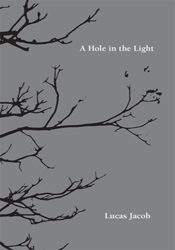
Lucas Jacob’s debut chapbook-length collection, A Hole in the Light, is a work fixated on suspension. Thematically, Jacob’s poems seek to suspend both desire and hope amid uncertainty. Narratively, we find the speaker suspended upon the surface of water, while in another instance he travels in a plane. Characters often hold their breath—an image reminiscent of Robert Pinsky’s assertion that, “The medium of poetry is the human body: the column of air inside the chest…” (from The Sounds of Poetry, A Brief Guide). The physical space of the poems suspends too; Jacob’s acute attention to syntax, to enjambment, and to the stanza—often un-rhyming couplets—allows his readers to enter a space in which patience is as much a pleasure as a virtue.
To suspend, of course, is also to restrain, and restraint characterizes the pacing and tone of these pieces. In general, each poem begins with a narrowly focused observation that ultimately—albeit subtly—expands outward to convey either the interior conflict of the speaker or the predicament of a female character. To this end, Jacob often makes use of ekphrasis. The form serves him well as a platform from which to leap from concrete imagery to abstraction. Of the collection’s ekphrastic pieces, which also include “Threshold” and “Two Views of Richard Serra’s Vortex,” I find this trajectory most deftly managed in “The Curvature of the Earth”:
“The lark, fittingly, is a mere hint
at the edge of the canvas, visible only
up close or if one knows to look for it.
It could be simply an accident of oil,
a smudge on the pea-green daybreak.
Perhaps it is a bird only in the eye
of the viewer who wants violence
to have a purpose and to come always
from feeling…”
Many of Jacob’s non-ekphrastic pieces also nevertheless depend on the observation of the speaker within and regarding his surroundings. This is indicated by several titles in the collection, including “From a McDonnell-Douglas MD80,” “Watching Hummingbirds at Cedar Creek Lake, TX,” “At Dinosaur Valley, Glen Rose, TX,” and, of course, “Voyeurism.” Indeed, there is often an element of voyeurism here; it is most notably present when perspective of the narrator is third-person omniscient and the subject is a female character. “Descent,” “More Flies with Honey,” and “The Royal She” are a few examples of these. The voyeur-like perspective can also be seen here, in “Tremor”:
“When it started, she was still looking
for her face in the circle of water
that pooled every morning on the black granite
countertop…”
These female-centered pieces combined with the equally, if not more, common perspective of a male speaker (often interacting with female relatives or love interests) present a multi-faceted display of desire, one which extends both inward and outward, which forms identity based on relationships and proximity, and which is always approaching but never quite reaching resolution. Some of Jacob’s most enchanting moments are those that acknowledge this tension explicitly, illustrating their own quiet self-awareness:
“Good dreams are that because they allow you
to touch the object of your desire
without the end of anticipation.”
(from “Recurrence”)
The precision of these pieces also prevents any missteps from flying under the radar, however. In that sense, breath, though an appropriate recurring image and theme, teeters somewhat on the precipice of overuse. We see “the breath of the new / wind” in “Against Despair”; “more breath than voice” in “Against Nostalgia”; and a character who “has a breath to give, and this is all” in “In Praise of Mortality,” just to name very few examples. Yet, ultimately, Jacob keeps the image aloft, so to speak, through the metaphor of breath as a means of suspension. That concept is most strongly exemplified here, in “More Flies with Honey”:
“To love,
she thought, as to be loved, is to measure
the distance of a breath and to hold it.”
A Hole in the Light’s strongest piece, certainly without coincidence, is fittingly titled “Suspension.” Positioned neatly in the center of the chapbook, in the second of its three parts, the poem itself hangs suspended among the others. Suspended, too, is the syntax, which winds through the piece’s single block stanza in what ultimately manifests as a single, unfurling sentence. This poem exemplifies much of the collection’s reliance upon the conditional, on what must be qualified with an “if” or a “might.” Yet, here, this suspension—this restraint—leads to openness and possibility, rather than restriction. We find that to be suspended is, finally, to be sustained. And, through the sustenance offered by these poems, we, like the oftentimes-hesitant narrator within them, must press forward, without resolution, into a world of uncertainty. I will not excerpt the poem for you here; go and find it. It’s worth the wait.




